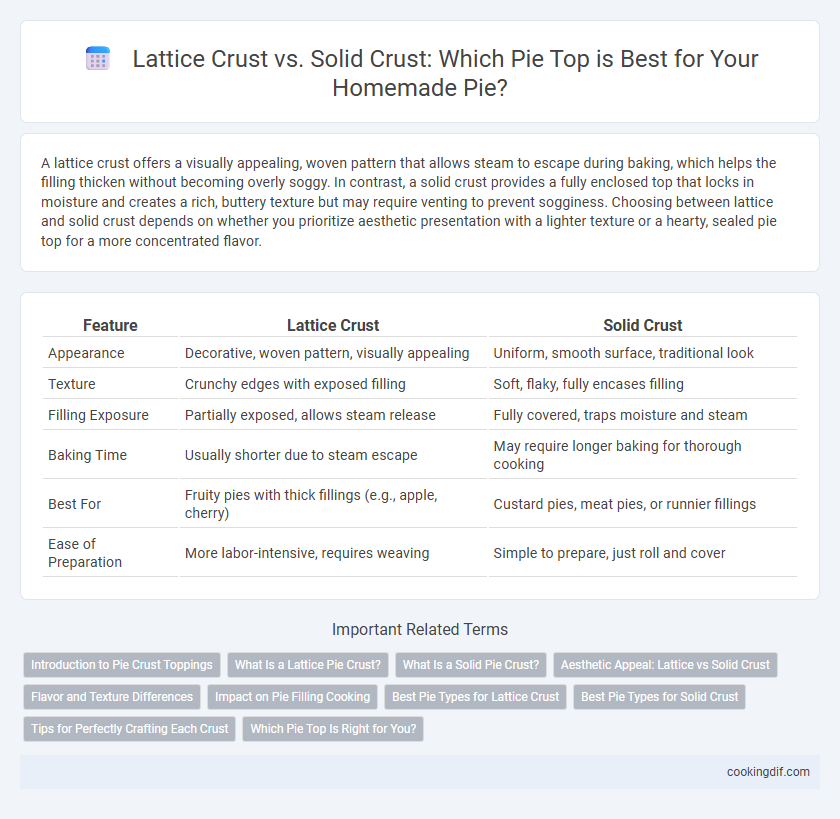A lattice crust offers a visually appealing, woven pattern that allows steam to escape during baking, which helps the filling thicken without becoming overly soggy. In contrast, a solid crust provides a fully enclosed top that locks in moisture and creates a rich, buttery texture but may require venting to prevent sogginess. Choosing between lattice and solid crust depends on whether you prioritize aesthetic presentation with a lighter texture or a hearty, sealed pie top for a more concentrated flavor.
Table of Comparison
| Feature | Lattice Crust | Solid Crust |
|---|---|---|
| Appearance | Decorative, woven pattern, visually appealing | Uniform, smooth surface, traditional look |
| Texture | Crunchy edges with exposed filling | Soft, flaky, fully encases filling |
| Filling Exposure | Partially exposed, allows steam release | Fully covered, traps moisture and steam |
| Baking Time | Usually shorter due to steam escape | May require longer baking for thorough cooking |
| Best For | Fruity pies with thick fillings (e.g., apple, cherry) | Custard pies, meat pies, or runnier fillings |
| Ease of Preparation | More labor-intensive, requires weaving | Simple to prepare, just roll and cover |
Introduction to Pie Crust Toppings
Lattice crust and solid crust are popular pie top options that influence both the pie's visual appeal and texture. Lattice crusts allow steam to escape during baking, resulting in a crisper filling and a decorative pattern, ideal for fruit pies like apple or cherry. Solid crusts provide a protective layer that retains moisture, creating a tender, flaky top suited for custard or cream pies.
What Is a Lattice Pie Crust?
A lattice pie crust consists of strips of dough woven over the fruit filling, creating a visually appealing pattern that allows steam to escape during baking. This type of crust enhances the pie's texture by offering a crisp, flaky top while showcasing the vibrant filling, unlike a solid crust that fully covers the pie and traps moisture. Popular in fruit pies such as cherry or apple, lattice crusts provide an aesthetic and functional advantage.
What Is a Solid Pie Crust?
A solid pie crust is a continuous layer of dough that completely covers the filling, creating a sealed top that locks in moisture and flavors during baking. This crust type provides a rich, tender texture and protects the filling, making it ideal for fruit pies like apple or cherry. Unlike lattice crusts, which expose the filling through woven strips, solid crusts offer a classic, uniform appearance and a satisfying buttery, flaky bite.
Aesthetic Appeal: Lattice vs Solid Crust
A lattice crust offers a visually intricate, woven pattern that showcases the pie filling, creating an inviting, artisanal appearance ideal for fruit pies. In contrast, a solid crust provides a smooth, uniform top that lends a classic, polished look, often preferred for cream or custard pies where the filling's texture is key. The choice between lattice and solid crust significantly impacts the pie's presentation, balancing decorative detail with traditional elegance.
Flavor and Texture Differences
Lattice crusts create a lighter, flakier texture with exposed fruit that intensifies the pie's aroma and adds a subtle caramelized flavor from the open vents. Solid crusts offer a richer, buttery, and more uniform texture by sealing in moisture, resulting in a tender and soft top layer that balances sweetness and preserves juiciness. The choice between lattice and solid crusts significantly impacts the overall flavor complexity and mouthfeel of the pie.
Impact on Pie Filling Cooking
A lattice crust allows steam to escape during baking, preventing the pie filling from becoming overly soggy and helping it to thicken evenly. Solid crusts trap moisture inside, which can result in a juicier filling but may require longer baking times to ensure the center cooks thoroughly. Choosing between lattice and solid crusts depends on the desired texture of the filling and the type of fruit or ingredient used.
Best Pie Types for Lattice Crust
Lattice crusts are ideal for fruit pies like apple, cherry, and blueberry, as the open weave allows steam to escape while showcasing the vibrant filling. This decorative crust enhances pies with juicy, colorful fruits by providing a balance of crisp texture and visually appealing presentation. Pies with thick, syrupy fillings benefit most from a lattice crust because it prevents sogginess and maintains structural integrity during baking.
Best Pie Types for Solid Crust
Solid crust tops provide a sturdy, golden-brown covering perfect for fruit pies that benefit from a sealed baking environment. Classic apple, cherry, and pumpkin pies excel with solid crusts, locking in moisture and enhancing the rich, spiced fillings. The solid crust's ability to create a crisp, flaky texture complements dense, custard-based pies, making it ideal for traditional holiday desserts.
Tips for Perfectly Crafting Each Crust
Lattice crusts require precise cutting and even spacing of dough strips to create a visually appealing, ventilated top that allows steam to escape, preventing sogginess. Solid crusts benefit from thorough venting by strategically placing slits or decorative shapes, ensuring even baking and avoiding a doughy center. Maintaining chilled dough and avoiding overhandling are crucial for both crusts to achieve a tender, flaky texture.
Which Pie Top Is Right for You?
Lattice crusts offer a visually appealing, airy texture that allows steam to escape, making them ideal for fruit pies needing thickening and a rustic look. Solid crusts provide a sturdy, fully enclosed barrier that locks in moisture and flavors, perfect for custard or savory pies requiring a consistent bake. Choosing between lattice and solid crust depends on the pie filling's moisture level and desired presentation, balancing texture and functionality for optimal results.
Lattice crust vs solid crust for pie top Infographic

 cookingdif.com
cookingdif.com